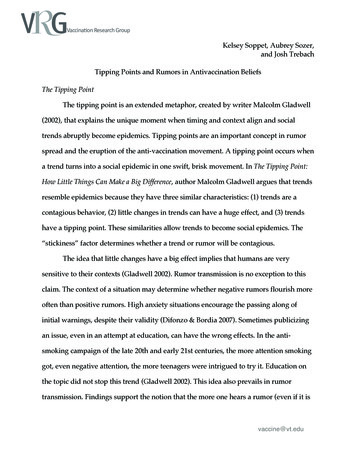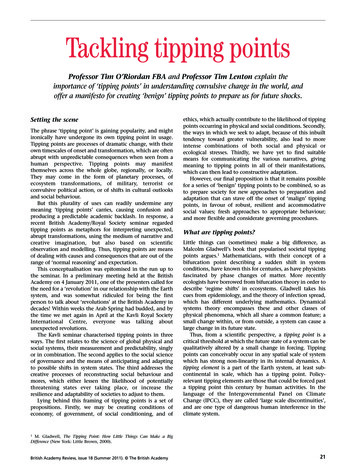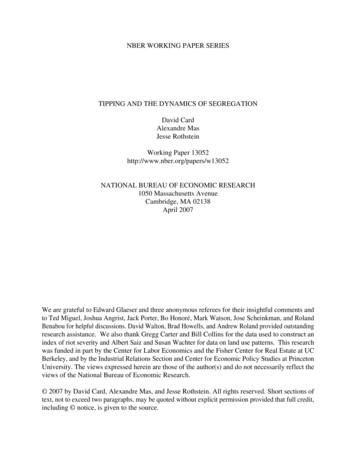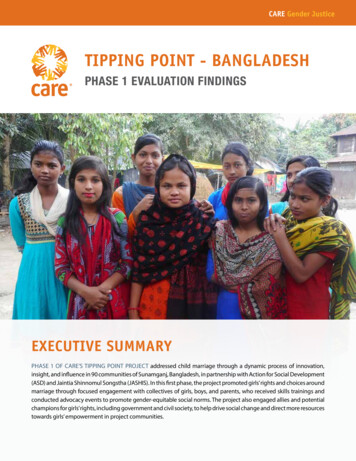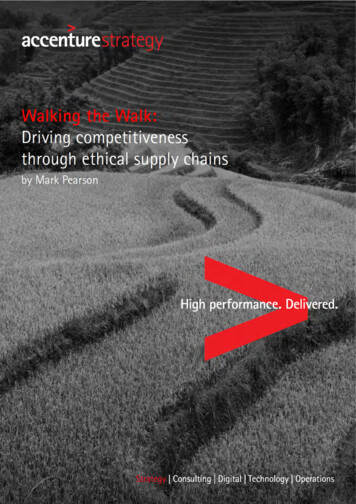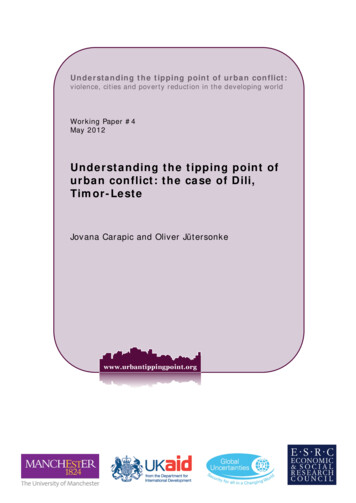
Transcription
Understanding the tipping point of urban conflict:violence, cities and poverty reduction in the developing worldWorking Paper #4May 2012Understanding the tipping point ofurban conflict: the case of Dili,Timor-LesteJovana Carapic and Oliver Jütersonke
Understanding the tipping point of urban conflict:violence, cities and poverty reduction in the developing worldWorking Paper SeriesJovana Carapic is a doctoral candidate and teaching and researchassistant in Political Science at the Graduate Institute ofInternational and Development Studies in Geneva, ver Jütersonke is Head of Research for the Centre on Conflict,Development and Peacebuilding (CCDP) at the Graduate Institute ofInternational and Development Studies in Geneva, Switzerland, andResearch Fellow at the Zurich University Centre for Ethics (ZUCE).oliver.jutersonke@graduateinstitute.chThe Urban Tipping Point project is funded by an award from theESRC/DFID Joint Scheme for Research on International Development(Poverty Alleviation). The Principal Investigator is Professor CarolineMoser, Director of the Global Urban Research Centre (GURC). The CoInvestigator is Dr Dennis Rodgers, Senior Researcher, Brooks WorldPoverty Institute (BWPI), both at the University of Manchester. Urban Tipping Point (UTP)The University of ManchesterHumanities Bridgeford Street BuildingManchesterM13 9PLUKwww.urbantippingpoint.org
Table of ContentsAbstract011 – Introduction022 – Approach, key terms and methods033 – Conceptual framework: the urban tipping process064 – A brief history of Timor-Leste115 – Socio-economic characteristics of Timor-Leste136 – Dili basics and current violence trends147 – Traditional authority versus liberal democracy168 – The east-west distinction and historical divides239 – Disembedding Dili2610 – Formal security providers3011 – Informal and private security providers3712 – Concluding overview4213 – Bibliography47
AbstractThis Working Paper seeks to analyse the 2006-07 Crisis in Dili through the lens ofthe urban tipping process of violent conflict. The conceptual framework of thisproject furthers our understanding of how different aspects of the urbanenvironment are interrelated, and acts as a guide to the organised complexity ofthe city. In the case study of Dili, the notion of the “tipping point” is used togenerate new insights about the Crisis and to question popular narratives, bothdomestically and internationally, about the role of the security sector andorganised youths in the collective violence that marked it. The participatoryresearch conducted in 2011 uncovered a number of common themes thatinterlocutors identified as underlying recent events in Dili: these include thediscrepancy between traditional forms of authority and the values of liberaldemocracy, the discursive role of the “east-west” divide, the presence of martialarts, ritual arts and other youth groups on both the city and sub-city levels, theimportance of past conflicts and disputes among the political elite in shapingconflict in present-day Timor-Leste, and the on-going stand-off and competition inthe formal security sector. Along these themes, the Working Paper offers asynthetic account of the environment in which the petitioner issue within thearmed forces came to tip into collective urban violence in 2006. According to thefindings, and as elaborated in the adjoining Policy Brief, it may be worthwhile toconsider Dili as a genuinely urban space with its own particular security dynamics,competing political and ritual authorities, acute land insecurity, and specificplanning needs.Keywords: Urban tipping process, 2006-07 Crisis, Traditional authority (lisan),youth groups, sacred houses (uma lulik), security sector governance, communitypolicing1
1. IntroductionOn 24 February 2011, the United Nations Security Council passed Resolution1969, extending the mandate of the United Nations Mission in firmedtheUNMITrecommendations of the UN Secretary-General, who in an earlier report hadcalled for the need to review and reform the country’s security sector (UNSG,2010). In particular, the Resolution stated that a continued UNMIT presence wasneeded to “delineate between the roles and responsibilities of the Falintil-Forcasde Defesa de Timor-Leste (F-FDTL) and the Policia Nacional de Timor-Leste(PNTL), to strengthen legal frameworks, and to enhance civilian oversight andaccountability mechanisms of both security institutions” (UNSC, 2011: 3).Indeed, security sector governance has been one of the main challenges facingTimor-Leste since its independence a decade ago. What the consequences offailure in this regard can be was vividly portrayed in the dramatic events of theso-called “Crisis” of 2006-07, when a dispute over unequal treatment within thearmed forces tipped into a frenzy of collective violence in the capital Dili. Whenthe dust settled, dozens of people had been killed, thousands of houses torched,and tens of thousands of residents displaced.This case study seeks to analyse the 2006-07 Crisis through the lens of the“urban tipping point” of violent conflict. This conceptual tool, underlying thepresent project, focuses on the process through which the complexities of theurban environment come together and foster the transformation – that is the“tipping” – of interpersonal conflict into collective violence. The analysis seeks tofurther our understanding of how different aspects of the urban environment areinterrelated, generate new insights about the 2006-07 Crisis, and questionpopular narratives, both domestically and internationally, about how this darkepisode of Timor-Leste’s recent history materialised in a setting marked by highyouth unemployment, social jealousy, historical rivalries within the politicalestablishment, land insecurity and a fragmented security sector.The overall aim of this Working Paper is to give a synthetic, and at timesprovocative, analysis of the environment in which the petitioner issue within thearmed forces came to tip into collective urban violence. Ultimately, the projectseeks to identify entry points for local and international stakeholders seeking tofoster the long-term political stability of Timor-Leste. Such recommendations forthe practitioner community are elaborated in the Policy Brief that accompaniesthis study.The authors would like to thank Dennis Rodgers, Caroline Moser, Laura Partridgeand Sandra Reimann for their substantive, logistical and moral support of thisresearch. Our gratitude also goes to the other team members of this project fortheir valuable feedback on earlier drafts of this Working Paper. We would also liketo thank Joao Boavida, the Executive Director of the Center of Studies for Peaceand Development (CEPAD) in Dili, for his insights, contacts, and encouragement.The peacebuilding vision of Interpeace, CEPAD’s partner in Geneva, is at theheart of the approach taken in this case study. Finally, we would like to thank allour interlocutors in Dili, who were extremely generous with their time, patienceand perspectives offered. Needless to say, the views expressed in this WorkingPaper are those of the authors alone, and do not represent those of any of theindividuals and organisations mentioned or related to this project.2
2. Approach, key terms and methodsWhile numerous studies have examined the reasons for the Crisis (notably ICG,2006; USAID, 2006) and analysed its consequences (e.g. Scambary, 2009;Robinson, 2010), none have looked in any detail at the dynamics of the conflictitself. That is, no study has offered an explanation as to why an administrativedispute over travel costs between a group of soldiers and the government“tipped” into large-scale collective violence. The Dili case study of this projectseeks to unpack precisely these dynamics through the lens of the urban tippingpoint.The events of 2006-07 in Dili, like similar ones around the globe (e.g. Nairobi in2008), give credence to common perceptions, in particular among the widerpublic, that uncontrolled urbanisation correlates with violence and a breakdown ofsocial order. Yet while on the aggregate interpersonal relationships within urbansettings tend to take on an impersonal style of social interaction, micro-levelanthropological studies have shown that within urban neighbourhoods, citydwellers continuously produce “urban villages” – that is, small-scale communityforms of living through repeated interaction with only a limited number ofindividuals within a localised territory (Rodgers, 2010: 6). Just as the 2009 WorldBank mandate on which the present study builds (Geneva Declaration, 2010), theresearch conducted thus distinguishes between city-level and sub-city-level dataand analysis.A related aspect guiding this research is the insight that urban environments canbest be described as complex yet organised – in the sense that they present“situations in which half a dozen or even several dozen quantities are all varyingsimultaneously and in subtly interconnected ways”; “the variables are many, butthey are not helter-skelter; ‘they are interrelated into an organic whole’” (Jacobs1961: 433; emphasis in the original). Thus, rather than assuming that urbansettings by themselves facilitate collective violence, conflict should be seen as aconstant factor, with attention having to shift to the reasons why in urbansettings it sometimes transforms from low levels of interpersonal conflict to acutelevels of collective violence.In light of this reasoning, the assumption underlying this project is that such atransformation is the product of urban complexity and is best understood throughthe lens of the “tipping point”. While the notion of the tipping point will beexplained in more detail in Section 3, it is important to stress here that it is aprocess through which the complexities of the urban environment come togetherand foster the transformation – that is the “tipping” – of interpersonal conflict tocollective violence. This “urban tipping process” can increase our understanding ofhow different aspects of the urban environment are interrelated, and can act as aguide to the organised complexity of the city – in this case Dili. Consequently, thepresent case study uses the notion of the “tipping point” to generate new insightsabout the 2006-07 Crisis and to question popular narratives, both domesticallyand internationally, about the role of the security sector and organised youths inthe collective violence that marked it.In many studies on urban violence, the definition of the term “urban” is simplyassumed, rather than defined explicitly. For the most part, this is the result of ageneral assumption that one knows what the label “urban” is attached to –visions of skyscrapers, traffic jams, and swarms of people on the go. While urbanplanners, social geographers and municipal administrators have developed acomplex set of indicators for how to determine the urban in counter-distinction tothe rural (see Jütersonke et al, 2007: 169), for the purpose of this project it issufficient to follow Louis Wirth’s classic depiction of urban settings as constituting3
“relatively large, dense, and permanent settlement(s) of socially heterogeneousindividuals” (Wirth, 1938: 8). This minimal definition of urban space brings tolight the fact that cities 1 are both social and physical entities, and that while theymight not be inherently violent, as Louis Wirth assumed, they are at the veryleast antagonistic (Rodgers, 2010: 10).“Tipping” refers to a process through which a phenomenon becomes increasinglygeneralised rather than specific. For the purpose of this project, the focus will beon the generalisation and spread of violence within the urban environment. Thetransformation of urban conflict into large-scale collective violence is what ismeant by the “urban tipping process”. This process is triggered when acombination of quantitative and/or qualitative factors alters the status quo of theurban environment (the steady level of conflict) and facilitates the spread of aphenomenon (a specific kind of violence such as youth violence) through theurban setting – significantly changing that environment in the process. Thespread of this phenomenon proceeds through the urban setting at varying speeds,yet it is only when a “conflict tipping point” is reached that large-scale changeoccurs.For the purpose of this case study, and in line with the urban tipping point projectdocuments, “conflict” is taken in a broad sense to refer to societal tensionsresulting from aspirations of power and authority by political leaders, businessentrepreneurs, the security sector and a variety of societal actors andstakeholders in the public realm. Such conflict is an ever-present phenomenon inevery society, and it does not necessarily have to entail or result in violence. Interms of Dili, such a conceptualisation of conflict will take the focus away from itssimple violent manifestation during the Crisis, and will offer a structural accountof the conditions leading to the outburst of violence as well as on therepercussions of this episode on contemporary society.While the primary focus of this project is thus on the actual “conflict tipping point”(i.e. the Crisis), this case study will attempt to offer a more general, andsensitively contextualised picture of the entire “urban tipping process”. Thisincludes the role of fault lines, conflict drivers, key actors, and populationthresholds. Instead of thinking about violence in Dili in terms of a “strong vsweak” state apparatus – and thus instead of focusing on deviance frominstitutional ideal types of modern statehood – the heuristic framework appliedplaces the emphasis on the concrete structural and socio-economic dynamics ofgovernance in Timor-Leste. In particular, the focus is on security sectorgovernance, and on services that are possibly also provided by alternative socialand political forces and groups, which thereby are resisting and challenginggovernmental structures.This case study is the result of in-depth desk-based and field research carried outin the spring and summer of 2011. The field work was conducted at the city,community, and sub-community levels. Specifically, the field research entailedparticipant observation and around 50 key informant interviews and groupdiscussions, including with youths in a cross-section of Dili’s neighbourhoods (andinvolving current and former “gang” members), community and religious leaders,local business owners, public transport employees, local civil society organisations,Timorese academics, students and university staff, government officials andministers, city authorities, members of the formal and informal security sector(including police officers and leaders of martial arts groups), international NGOs,UN agencies and the donor community.1The concepts ‘urban’ and ‘city’ will be used interchangeably in this study.4
What is more, the research conducted for this case study builds on a World Bankstudy on urban violence in Dili, in which one of the authors was involved in 2009.The study, which has fed into the World Bank’s report on Violence in the City(2010) and was also published separately as a working paper of the Secretariat ofthe Geneva Declaration (2010), conducted household surveys and focus groups infour neighbourhoods of Dili – Fatuhada (pilot), Perumnas, Delta III and Ai Mutin.A series of key informant interviews were also undertaken. Noting that “urbanviolence in Dili can often shift from collective to interpersonal forms in dramaticfashion”, the study found that due to “the weak state of crime and healthsurveillance and the fact that most minor incidents are dealt with throughcustomary means, if at all, it is difficult for international and domestic authoritiesto anticipate the onset of acute forms of urban violence” (Geneva Declaration,2010: 11).The present project seeks to take this observation to heart when exploring thedynamics that led to the 2006 Crisis. But instead of engaging in a further roundof survey research (Dili residents already suffer from “survey fatigue” as it is),the participatory research undertaken for this case study primarily involvednarrative conversations with the underlying aim of questioning thepresuppositions of the development community, public authorities, civil societyactors and ordinary residents regarding the prevailing public discourse about the“problem” of youth unemployment, violence, and the assumed link between thetwo. The field research itself, as well as the present report and subsequentpresentations and stakeholder meetings in Dili and Geneva, seek to stimulatepeople to think “outside of the box” and critically assess the environment(especially in relation to the presence of a plurality of competing authorities and amushrooming of official and unofficial security providers) in which societal conflictand interpersonal violence occurs.Apart from reviewing the data and insights derived from the World Bank study,the first phase of the research conducted for this case study involved anextensive review of both the academic and practitioner literatures. The aim herewas to analyse the historical development of violence in Timor-Leste, tease outcurrent socio-economic trends, and identify standard narratives and assumptionsof the “development discourse”. This secondary material was furthersupplemented by data obtained from various UN agencies, local and internationalNGOs, and Timorese government ministries.Against this backdrop, the second phase of the research involved participatoryfield work seeking to engage in a more iterative approach to understanding the“onset of” or “tipping into” collective violence. The research was conductedthrough what can best be described as a basic version of “grounded theory”, orthe sequential reformulation of tentative arguments. Rather than using theory todevelop a set of hypotheses that are then tested by means of empirical analysis,the work was conducted “backwards” by first collecting information and theninductively reorganising it into categories, patterns, themes, and narratives(Glaser and Strauss, 1967: 238-9). As the fieldwork progressed, the researcherstested the emerging narratives and reoccurring themes – by asking multipleactors similar questions to see if the answers matched – and then repeatedlyrefined them in a series of reflective feedback loops. This process of triangulationincreases the credibility of the research by basing claims on multiple viewpoints(Cresswell, 1994).The aim of the participatory approach was not just to get a sense of how differentstakeholders experienced the Crisis, but also to see how individuals from variousbackgrounds interpreted the violence and its causes almost six years on. Have5
the public authorities learned any lessons from the Crisis? Have the underlyingfault lines been addressed? Could the violence of 2006 be repeated?There was considerable disagreement amongst the participants in terms ofinterpreting past, current and anticipated levels of violence. Views also divergedon the issue of how episodes of collective violence are triggered, and what couldor should be done to avoid them in the future. Generally, however, a number ofcommon themes soon emerged, particularly the discrepancy between traditionalforms of authority and the values of liberal democracy, the discursive role of the“east-west” divide, the presence of martial arts, ritual arts and other youthgroups on both the city and sub-city levels, the importance of past conflicts anddisputes among the political elite in shaping conflict in present-day Timor-Leste,competing land claims and the on-going stand-off and competition in the formalsecurity sector. The analytical narrative offered in this Working Paper is largelystructured along these themes.3. Conceptual framework: the urban tipping processIn sociology, the term “tipping point” refers to a unique or previously rarephenomenon that all of a sudden becomes rapidly and drastically more common.The sociological use of the phrase was brought into existence by Morton Grodzinsin his study of integrating neighbourhoods in the USA. In his 1958 work entitledThe Metropolitan Area as a Racial Problem, Grodzins found that most of the whitefamilies remained in a neighbourhood as long as the comparative number of blackfamilies remained low. However, when the number of black families became toohigh, the white families would move out en masse. This rapid exodus from theneighbourhood was labelled “white flight”, and the moment when it happenedwas termed the “tipping point” (Grodzins, 1958).In a number of studies dealing with interracial neighbourhoods in the USA,Thomas Schelling (1969, 1971, 1972, and 1978) came up with two distinctmodels of residential segregation between whites and black. These included the“proximity model” and the “bounded-neighbourhood” model. The proximity modelshows segregation through simulation, while the bounded-neighbourhood modelexplains at which point segregations starts to occur – that is, the point at whichthe neighbourhood “tips”.The bounded-neighbourhood model, or, as it is better known, the “neighbourhoodtipping” model, is perhaps the more important of the two given the subject athand (Schelling 1971: 143-86). According to Schelling, the phenomenon of“neighbourhood tipping” occurs when a neighbourhood dominated by whiteresidents, after a number black families move in, suddenly begins the process oftransforming into a neighbourhood increasingly dominated by black residents.Schelling emphasises the fact that this process of moving out/in is not steady orlinear – rather, once it is “triggered”, it appears to accelerate until a tipping pointis reached.According to Schelling, individuals have different thresholds of acceptance when itcomes to the number of individuals of the opposite colour residing in theneighbourhood. The moving out process is “triggered” by the individuals with thelowest tolerance level. Once these individuals have moved out, a void in theneighbourhood needs to be filled. If this void is filled by black individuals, thenthe proportion of blacks in the neighbourhood may reach the next threshold andtrigger the moving out of the next group of white individuals who are only slightlymore tolerant than the first group(s). This process continues, accelerating at eachstage until the neighbourhood becomes predominantly, or completely, black. It isimportant to mention that this pattern also happens the other way around. That6
is, an all-black neighbourhood may be “tipped” into an all-white neighbourhood.Prejudice goes both ways.“Tipping” is thus described by Schelling as a process that occurs when an originalequilibrium is disrupted by something (such as mass migration of one ethnicgroup into a neighbourhood previously occupied by another ethnic group) causinga change in the environment and the emergence of a new equilibrium (Schelling1971: 143). Moreover, for the tipping process to be triggered, this “something”does not need to be a significant or large change. It might instead only have asmall effect on the system, but this effect in turn triggers a chain reaction thatmoves the system away from the original status quo and towards a quantitativelyand/or qualitatively new one. Schelling’s work highlights the fact that an outcomesuch as collective violence can certainly be triggered by what might appear to bea trivial matter – such as, during the 2006-07 Crisis in Dili, a disgruntled group ofsoldiers (the so-called “petitioners”) claiming they were being unfairly treated.As insightful as the bounded-neighbourhood model may be, Schelling himselfwould later admit that it tells us very little about the behaviour that leads to aparticular outcome such as neighbourhood segregation or even collective violence(Schelling, 2006: 259). In order to address these shortcomings, Schellingproposes that the process which brings about an outcome such as segregation orcollective violence has to be taken into account as well. But while Schelling placesemphasis on the incentives of individuals and the behaviour that the incentivesmotivate (Schelling, 2005: 259), the present case study takes a more structuralapproach and focuses on the fault lines and conflict drivers (described below) insociety that set the stage for certain key actors to engage in violence, and lowerthe thresholds or tolerance of individuals to behave in a violent manner within theurban environment.Perhaps more directly related to the phenomena of collective violence in urbanenvironments and “tipping” is the work of Mark Granovetter who, in 1978,published a paper entitled Threshold Models of Collective Behaviour. In this paper,Granovetter took the notion of “tipping” as described by Schelling and applied itto “paradoxical” phenomena such as riots or revolutions. For Granovetter,“paradoxical” phenomena are those for which the observable macro-outcomes donot seem to be intuitively consistent with what is going on at the micro-level (i.e.with the preferences and desires of individuals). The “threshold model” of humanbehaviour thus supposed that individual preferences are unrelated, or evenopposed to, the observable outcomes such as collective violence (Granovetter,1978: 1420-43).For Granovetter, key is the environment within which people find themselves, andnot their individual preferences. He argues that individuals need “different levelsof safety” before making a decision, with the “level of safety” not necessarilyimplying that the environment is safe, but rather that the individual receivesbenefits as a result of the action, and the he or she will not necessarily bereprimanded for taking it – especially if this action involves breaking the law suchas rioting or engaging in other forms of collective violence. What determines anindividual’s decision to engage in collective behaviour is thus not necessarily hisor her preference for that behaviour, but the “safety” of action. This safety is aproduct of “thresholds”, which Granovetter defines as the proportion of the groupan individual would have to see making the same decision to engage in aparticular action before doing the same (Granovetter, 1978: 1422). 22This does not mean that what is going on here is simple contagion, i.e. the mere imitation of the lastindividual observed. Contagion does not take into account that more than one person might have tomake a decision before an individual feels compelled to make the same one. Thus, in the broader7
What this means for collective behaviour is that the macro-level outcome – suchas collective violence – depends on the thresholds of the population. But whileGranovetter focuses on individual thresholds, he does not explain whatdetermines the threshold. For him the only influence is the presence of otherpeople engaging in the same action. While this is important, it is very hard todetermine outside of a controlled environment what the number of people wouldhave to be before a single individual decides to engage in an action that he or shemight not necessarily have a preference for. As a result, and as mentionedpreviously, this study assumes that the structural environment also has an effecton the population threshold. For instance, if violence is taken to be a normal wayfor dealing with conflict in a population (both in the private sphere where it mightmanifest itself as domestic or gender-based violence, and in the public spherewhere it may take the form of state, or state-sponsored, oppression), then giventhe opportunity (when there is a level of safety, such as a sense of “lawlessness”during the 2006-07 Crisis) people are likely to engage in collective violence evenif individually they do not prefer to act in a violent manner.What can be taken away from the work of Shelling and Granovetter is thatdifferent sociological phenomena – be they neighbourhood segregation, riots, orrevolutions – spread through an environment in a similar pattern. The same pointwas made more recently by Malcolm Gladwell, whose book The Tipping Point:How Little Things Can Make A Big Difference (2000) inspired the development ofthe present project and consequently this study. Drawing on the academicliterature of the “tipping point”, Gladwell’s main claim is that an outcome, orpresence of a phenomenon in society is determined by a critical juncture,threshold, or “tipping point”, which signals a key moment in the evolution orspread of the phenomenon. In line with Schelling’s theory, this moment ischaracterised by the “coming together” of isolated events into a significant andaccelerating trend or trajectory. Importantly, and unlike Schelling andGranovetter, Gladwell does not focus solely on the tipping point of a phenomenon,but on the actual process that brings it about. For him, the process is made up ofthree interrelated parts: the “law of the few”, the “stickiness factor”, and the“power of context”.The “law of the few” stipulates that the attainment of the tipping point, whichtransforms an event into a significant outcome, usually requires the interventionof a number of influential types of people. There are three types of such peoplethat act as catalysts of the “tipping point” (Gladwell, 2000: 30-88). The first arecalled connectors, individuals who know a lot about other individuals, and act asconduits among all of their acquaintances, helping them to create connectionsand relationships that might not have otherwise happened. In this sense,connectors are those select people who have access and opportunities to worldsto which average individuals do not belong or have access to – they are the onesthat spread information or make previously unknown information known. Thesecond group of people are labelled mavens: individuals who are experts onparticular subjects. Such people not only have a desire to give other people thebenefit of their expertise and a
the lens of the "tipping point". While the notion of the tipping point will be explained in more detail in Section 3, it is important to stress here that it is a process through which the complexities of the urban environment come together and foster the transformation that is the - "tipping" - of interpersonal conflict to



